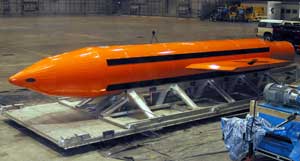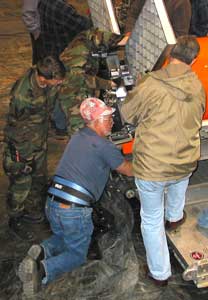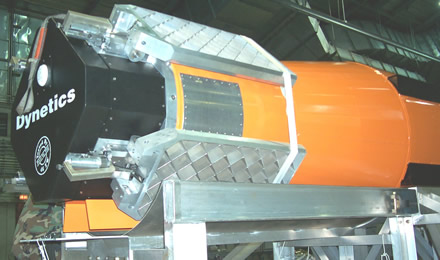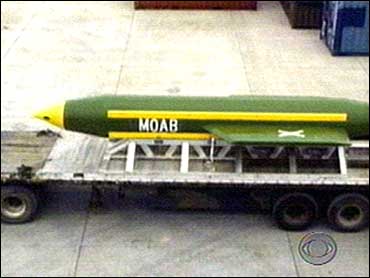Direct Strike Hard
Target Weapon / Big BLU
MOAB
Although the Direct
Strike Hard Target Weapon concept was unfunded as of 1997,
in early 2002 it was reported that Northrop-Grumman and
Lockheed Martin were working on a 30,000-lb. earth
penetrating guided conventional weapon, said to be known
as "Big BLU" or "Big Blue" [which is also the nickname of
the 15,000-lb surface burst BLU-82]. Big BLU will be GPS
guided and feature cobalt-alloy penetrator bomb body that
enables it to penetrate to depths of up to 100 feet below
the surface before detonating. The bombs are so large that
a bomber such as the B-2 could carry one of them. As of
March 2002 reportedly three Big BLUs had been ordered by
the Air Force on an urgent basis ["Inside The Ring," By
Bill Gertz and Rowan Scarborough, Washington Times March
15, 2002 Pg. 10].

The Air Force is also investigating whether a similar size
weapon could be used in a blast-only configuration, to
replace the BLU-82 Daisy Cutter blast weapon dropped from
the MC-130.
The U.S. Air Force is developing a new, 2nd generation,
ten ton large, low air burst bomb. It will replace the
older "Daisy Cutter" 7.5 ton bomb developed during the
1960s. This was a 7.5 ton bomb using a semi-liquid
explosive for clearing landing zones in the Vietnam
jungle. The terms "Daisy Cutter" actually comes from the
four foot probe at the bottom of the bomb which triggered
the explosion without creating a crater (helicopters don't
like to land in craters.) The probe was later replaced
with a radar altimeter fuze, but the nickname "Daisy
Cutter" stuck. The official designation was BLU-82 (or
"Big Blue"). Until the BLU-82 came along, the biggest
non-nuclear explosion obtainable was with a FAE (Fuel Air
Explosives). FAE works by dropping a bomb that is
actually a large aerosol dispenser. When the FAE
"explodes" it first dispenses a large cloud of flammable
material (anything like gasoline or propane will work).
The cloud is then ignited and huge explosion results.
There's one drawback, the size and density of the aerosol
cloud depends a lot on the wind, air temperature and
humidity. So the power of the explosion will vary a lot.
But it's difficult to get a FAE to work in a bomb larger
than 2000 pounds. So the replacement for the BLU-82 bomb,
called MOAB (Massive Ordnance Air Burst) simply uses more
of the slurry of ammonium nitrate and powdered aluminum.
In dry, dusty conditions, the Daisy Cutter produces a
mushroom cloud similar to that created by a nuclear
explosion (and for the same reason, the sheer size of the
explosion creates an upward pull that sends up a
"mushroom" of smoke and dust on a column of smoke).
|
A Massive Ordnance Air Blast weapon is prepared
for testing at the Air Armament Center here March
11. The MOAB is a precision-guided munition
weighing 21,500 pounds and is the largest
non-nuclear weapon in existence. (DOD photo) |
 |
Air Force workers prepare the Massive Ordnance Air
Blast weapon for testing at the Air Armament
Center on March 11. The MOAB is a precision-guided
munition weighing 21,500 pounds and is the largest
non-nuclear weapon in existence.
(DOD photo) |
 |
In addition to a more powerful explosion, MOAB
doesn't need a parachute, like the Daisy Cutter, but
uses a GPS (like JDAM) and an aerodynamic body to
detonate the bomb at a precise area. Thus the MOAB can
be dropped from a higher altitude (like outside the
range of machine-guns and rifles). Like the Daisy
Cutter, MOAB is shoved out the back of a cargo aircraft
(usually a C-130, but since the MOAB uses GPS and higher
altitude drops, the C-17 can probably be used as well.)
MOAB is a highly destructive and terrifying weapon. If
used in Iraq, it would demoralize any Iraqi troops in
the vicinity who survived the explosion. The force of a
MOAB explosion is sufficient to knock over tanks and
kill any people within several hundred meters of the
detonation. After the 1991 Gulf War, the United States
started to get rid of it's various FAE weapons. But some
were left in the inventory when the Afghanistan came
along and the success of Daisy Cutters there, plus the
new Russian research in FAE weapons, led to the new
American research effort. There may be larger, or simply
more powerful, FAE weapons in the works. But for the
moment, MOAB, using pretty old fashioned technology, is
the biggest non-nuclear bomb around.
The Direct Strike Hard Target Weapon is a 20,000 lb. class
precision guided, adverse weather, direct attack bomb
employed on the B-52 and B-2 aircraft. It will make use of
the GCU developed by the JDAM program which uses GPS aided
INS for adverse weather guidance. Precision accuracy will
be attained by using differential GPS (DGPS) technology
demonstrated on programs such as Enhanced Differential GPS
for Guidance Enhancement (EDGE) and Miniature Munition
Technology Demonstration (MMTD). The weapon will make use
of the JDAM interface under development for the B-52 and
B-2 aircraft and would be carried internally using new
suspension hardware within the bay. The warhead will be a
20,000 lb. penetrator with dense metal ballast. This
concept uses the Hard Target Smart Fuze (HTSF), an
accelerometer based electronic fuze which allows control
of the detonation point by layer counting, distance or
time. The accelerometer senses G loads on the bomb due to
deceleration as it penetrates through to the target. The
fuze can distinguish between earth, concrete, rock and
air.
During the Second World War the British designer Barnes
Wallis developed the largest conventional bombs used in
combat. Wallis first designed the "Upkeep" bouncing bombs
that were used during the Dambusters Raid on 16th May
1943. The rotating bouncing bomb exploded at the base of
the retaining wall of the dam, producing heavy floods and
damaging German production in the Ruhr.
Wallis next produced the 12,000-lb Tallboy, also known as
the earthquake bomb. Tallboy was 21" long, with an overall
diameter of 3'8", while the bomb body itself was 10'4"
long and 3'2" in diameter. It weighed a total of 11,855
pounds, of which 5,200 pounds was Torpex D1 explosive. The
weight of the case was thus a high proportion of the
weight of the bomb. Dropped from 20,000 feet, a Tallboy
made a 80ft deep crater, 100ft across. The bomb had a high
terminal velocity, variously estimated at 3,600 and 3,700
feet a second [much faster than sound], and at these
speeds it could go through 16ft of concrete. It was used
for attacks on tunnels, V-1 Flying Bomb launch sites, and
other high-priority targets. Its most important use was in
the sinking of the German battleship Tirpitz at anchor in
Norway, on 12 November 1944. Over 700 Tallboys were
dropped during the War.
In 1945 Barnes Wallis developed the 22,000lb Grand Slam,
which remains the largest conventional bomb ever used in
action. The 10 ton (22,000 pound) "Grand Slam" was
26-feet, 6-inches long. Its hardened casing was cast in a
single piece in a sand mold, using a concrete core. The
"Grand Slam" could reportedly penetrate though 20+ ft of
concrete. The first one was dropped on Germany on 14th
March 1945. It hit the ground about 80 feet from the
target, but it created a crater over 100 feet deep. This
bomb was used with great effect against viaducts or
railways leading to the Ruhr and also against several
U-boat shelters. In one raid on 27 March 1945 against the
U-Bootbunkerwerft "Valentin" submarine pens near Bremen,
two Grand Slams penetrated 7 meters (23 feet) of
reinforced concrete, bringing down the roof. In total, 41
Grand Slams were dropped during the war.


|